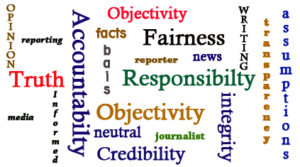
Did you ever ask yourself when investigative journalists, what year, what decade lost their way. I used to love print, the newspaper offered….. well news.
In the 19th century a key cultural advance was the professionalization of news gathering, handled by professional reporters. A reporter would have to produce a story based on fact and present facts to their editor for approval before it could go to press. Sources needed to be provided to confirm their version of the story and to substantiate the information as fact. Official records, confirmed representatives in government, a witnesses of crime or accident would have to be submitted as support to get an article to print. Journalists back in the day were also urged to be doubtful without being cynical about the information and the sources that provided it.
There was a saying once that a college instructor quoted in my communications class that kind of encapsulated how one should approach sources that could not produce hard fact. It started with the City News Bureau of Chicago, they would state “If your mother says she loves you, check it out.” As a rule of thumb, but specifically when reporting on something controversial or damaging journalists used to have to submit multiple sources to get a story to press.
Today “news” is written or reported that the evidence or information was provided by anonymous sources. The past standard was that publications would prohibit the use of unnamed sources at all times. Evidence/information from an anonymous source must be corroborated by a multiple sources prior to being approved for print.
We’ve come to a point where a journalist can state that a source refuses to supply information without the protection of anonymity, including many representatives in our government. Frequently this produces an editorial decision and in today’s journalist culture and it goes to press.
The more one follows the news, the more we find that the information is unreliable. The source used the press to pursue a personal agenda, is purely disseminating propaganda or to harm another person. I won’t even bother to go into the belief that journalists fabricated sources simply to get their “news” into print.
Sensationalized reporting, is defined as a journalist presenting information in a way that provokes public interest and excitement, at the expense of accuracy. Can you remember a recent occasion when a source came forward on the record to support accuracy of an article? Or if they did come forward they later had to back pedal because the information wasn’t verified and turned out to be inaccurate. Multiple source corroboration used to resolve the inaccuracies.
We’ve become mired in bullshit, not trusting our own news publications because journalist integrity, ethics and standards seem to no longer prevail.
It’s a shame that most have lost their way and sensationalized reporting has become our standard.
These quotes seem like a fitting ending.
“Objective journalism and an opinion column are about as similar as the Bible and Playboy magazine.”
Walter Cronkite
“In journalism, there has always been a tension between getting it first and getting it right.”
Ellen Goodman
“The lowest form of popular culture – lack of information, misinformation, disinformation, and a contempt for the truth or the reality of most people’s lives – has overrun real journalism. Today, ordinary Americans are being stuffed with garbage.”
Carl Bernstein

